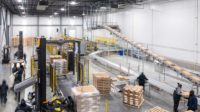High demand for cold storage space will undoubtedly continue throughout 2023, as food and beverage companies look to quickly increase capacity. With demand expected to continue to outpace supply, the booming cold storage and broader industrial markets will drive competition for space. This, combined with ongoing market disruptions, will make build-to-suit cold storage facilities especially challenging from a location and timeline standpoint. As a result, retrofitting an existing space or building out a speculative warehouse will most likely become increasingly popular and advantageous among those seeking to simultaneously prioritize site and schedule.
Cold Storage Demand Will Outpace Supply, Making Ideal Sites Scarce
The need for strategically placed cold storage facilities in markets across the country continues to increase, with those near large population centers being the most sought after. However, competition for land among both cold storage and traditional industrial users and investors is making ideal sites scarce and pushing new construction further away from major metropolitan areas. Speed to market benefits are often taking priority over location as material delays continue to extend project schedules.
Demand is increasing for cold storage distribution space in smaller, but growing, metropolitan areas, as developers look to match trends among those in traditional ecommerce warehouse development when it comes to locations capable of immediate deliveries. As a result, developers are building smaller-scale cold storage facilities suited for distribution within these markets. Those suited for potential production requirements are often being built in outlying municipalities.
Investor Interest Will Continue to Drive Speculative Development
In recent years, speculative cold storage development has become an advantageous way for investors to capitalize on the rapidly-growing demand for temperature-controlled space. With total square footage under construction in 2022 more than 10 times that of pre-pandemic levels, the market for speculative cold storage remains strong moving into 2023.
The unique nature of cold storage operations makes it impossible to create a one-size-fits-all facility. Rather than developing true speculative cold storage builds, developers may opt to add incremental upgrades that optimize a traditional warehouse for cold storage or food manufacturing use. Upgraded roof loads, increasing building envelope insulation (increased R-values), insulated overhead doors and a more extensive sanitary plumbing layout are just a few of the items that can prepare a facility for freezer/cooler/production installation and decrease time on any tenant requirements.
Additionally, there has been a significant increase in traditional speculative development nationwide. Beyond building square footage, developers and owners are now looking to strategically maximize facility and site flexibility to increase marketability, decrease time on retrofit projects and accommodate a wide range of tenant and end-user needs. Traditional speculative builds now often include full dock packages, new building lighting throughout and upgraded HVAC packages, as well as speculative office spaces.
While the increase in both cold storage and traditional speculative warehouse development will exacerbate competition for space for cold storage users and operators seeking to build ground-up facilities, the shift toward flexible designs will continue to drive the movement toward speed to market prioritization regardless of end-user type.
Retrofitting Will Be Advantageous for Those Looking to Quickly Increase Capacity
Owners who choose to retrofit an existing space or buildout a speculative warehouse can simultaneously prioritize both site and schedule, as well as mitigate challenges caused by ongoing market disruptions as the industry continues to see long lead times for key commodities such as steel, roofing, rigid insulation and electrical equipment. Retrofitting an existing space can provide for increased production capabilities or storage to occur months earlier than it would when building a ground-up facility.
While retrofitting can offer many benefits in terms of location and schedule, there are still potential challenges to the buildout including structural reinforcement, upgraded power requirements, floor slab removal and specialty replacements for freezer and production users, upgrading or upsizing sanitary and domestic water utilities and increased fire water requirements. Those who choose to retrofit a building in an already overcrowded metropolitan area are still able to take advantage of the consumer population in immediate proximity.
Design-Build Delivery Will Be Critical for Success
In a normal market setting, cold storage owners and operators who prefer the design-build delivery type benefit from both a cost and schedule standpoint, as the integrated approach and work in the proposal phase consistently result in the most functional solution and tremendous time savings. Moving into 2023, design-build delivery will be especially beneficial in both new construction and retrofitting scenarios as it not only addresses the speed to market demands of owners and operators, but also helps mitigate ongoing material pricing increases and extended lead times.
Unlike traditional delivery methods that treat the phases of design, bidding, and construction sequentially, the design-build process combines the benefits of design ownership, financial risk of volatile construction materials pricing, management of capital expense and expediting schedule all under a single point of responsibility. Preliminary design is completed during the proposal process and owners benefit from the speed at which design-build delivery moves. Once a project is awarded, the design-builder can move immediately through the buyout process to lock in material pricing and delivery dates while still completing design. In normal circumstances, this offers a substantial advantage over the traditional design-bid-build delivery process. In 2023, the benefit will be critical to meeting the urgent capacity needs of food and beverage companies and overcoming ongoing market challenges and supply chain disruptions.




